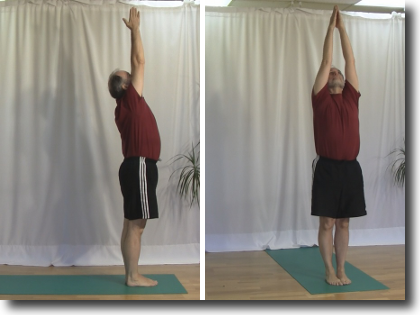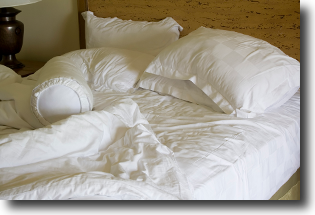A loud groan escapes Alice’s lips. She is standing by her bed stretching every muscle in her body as she reaches to the ceiling with her arms. Her head is leaning back and there is a big arch in her back. “Oh! That feels so good.” Says Alice.
This morning stretch is similar to a common yoga pose called Urdhva Hastasana and they both have much of the same benefits.
What is Urdhva Hastasana
Urdhva Hastasana is a standing pose that is the first and last pose of the Sun Salute Series A. Unlike a lot of yoga poses there is no binding or twisting in this pose.
When you do Urdhva Hastasana you stretch your abdominal area, the muscles of your shoulders and arms. It also gives a nice stretch to your back and legs.
This pose will help you with Asthma, relieves mild anxiety and back ache.
How to do Urdhva Hastasana
You start in Tadasana, standing tall with your feet together, your arms by your sides, your torso tall and your gaze to the horizon.
To enter Urdhva Hastasana move your arms out to the side and up over your head. As your arms come together above your head lift your chin and gaze up through your eyebrows to your hands. As you hands come together keep your arms straight and your shoulder blades down you back away from your ears.
You hold here in the pose for several breaths.

Like an early morning stretch, Urdhva Hastasana stretches your back and shoulders but there are some differences.
To exit the pose you take your arms out to the side again and lower them down towards your sides once again returning to Tadasana
How to get the most out of Urdhva Hastasana
Unlike that morning stretch that Alice did you want to avoid arching your back and you want to keep your arms straight as you raise them up over your head.
Avoid arching your back
In Urdhva Hastasana you do not arch your back. You are attempting to keep your back more or less straight.
As you raise your arms up over your head keep your awareness on your torso. Draw your lower ribs in to keep your back straight. Engage Uddiyana Bandha to provide support to your lower back.
Tuck your tail bone in slightly to help keep your hips level and prevent arching in the lower back.
Keep your arms straight
As you bring your arms up over your head, you may discover that your hands will not come together unless you bend your arms. This is due to some lack of flexibility in your shoulders that are preventing your arms from coming closer together. Bending your arms and bringing your palms together will take all of the stretching out of your shoulders.
You will get more benefit from this pose if you continue to keep your arms straight and work with the muscles in your shoulders to bring your arms and hands closer together.
There are couple of problem areas that you need to watch out for to avoid injury.
How to protect your upper back and neck from tension
You may discover that when you do this pose that your shoulders are rising up towards your ears as you raise your arms up over your head. This will cause tension in your upper back and neck which is the opposite of the affect that you are seeking.
There are two things that you can do to protect your upper back and neck.
As you start to move your arms out to the side turn your palms from facing your thighs to facing forward by the time your arms are about half from your sides to shoulder height. Continue rotating your palms as you lift your arms to shoulder height. When you arms are at shoulder height your palms will be facing up towards the ceiling.
Lift your chin slightly as you continue to raise your arms up to vertical. Your palms continue to face upwards and eventually as your arms come closer together them will be facing each other.
The rotation of your palms from facing inward to facing upward helps to keep your shoulder blades down your back and away from ears.
At the same time that you are moving your arms up draw your shoulder blades down your back.
These two actions, rotating of your hands and moving your shoulder blades down your back will keep your shoulders away from your ears and avoid bringing tension to upper back and neck.
How to protect your lower back
Short hamstrings can cause some issues with your lower back. When you stand tall with straight you may discover that the back is rounding. To provide proper support for your back you need to maintain the natural curves in your back.
The rounding in your lower back can be due to shortness in hamstrings. Your hamstring muscles attach at the back of your hips and just below your knees. When you stand tall with straight legs your short hamstrings will cause the back of your hips to be pulled down.
Imagine that your hips are are bowl full of water. To support your back properly you need to keep all of the water in bowl. You level your hips by bending your knees slightly taking some tension out of your hamstrings. This reduction of tension in your hamstrings will allow the back of your hips to rise.
What to do when there is no room to move your arms out to the side
Sometime you may be a very crowded yoga class with people close to you on either side. If you move your arms out to the side you are going to hit the person on either side of you with your arms. There are two very different actions that you can do to prevent this from happening and still get the full benefit of the pose.
First you can adjust your position relative to the people on either side of. This will require some co-ordination with the people on either side of. You either take a step forward or back relative to the person on either side of you. Now when you swing your arms out to the side you will be going either in front of or behind your neighbour. You will no longer be hitting them in the side as you raise your arms up.
The second way that you can avoid hitting the people beside you in this pose is to change the direction in which your arms move.
Rather than swinging your arms out to the side and overhead, bring them forward and up to overhead.
When you move your arms forward and up there is no rotation in your palms. They continue to face inwards as you raise your arms up.
There are a few things to be aware of when you move your arms forward rather than out to the side.
- You need to engage Uddiyana Bandha to protect you lower back as you bring your arms forward and up to shoulder height. You do this to protect your lower back muscles.
- You need to focus on your shoulder blades and insure that they stay down your back and away from your ears.
Summary
While there is a lot of similarity between that morning stretch that Alice had with Urdhva Hastasana there are few significant differences.
You keep the natural curves in your back as you reach your arms up towards the ceiling.
You keep your arms straight and your shoulder blades down your back as you bring your hands together over your head.
When done properly Urdhva Hastasana stretches the muscles of your back, shoulders and arm pits. It will also helps to relieve asthma, fatigue, and back ache.
Next Step
Ask your yoga teacher to check that you shoulders are in the right place and that you are not arching your back when you enter Urdhva Hastasana.
Additional Reading
This article How to avoid injuring your neck in upward facing dog tells you how to avoid injuring your upper back and neck when you do Upward Facing Dog.
Urdhva Hastasana is the first and last pose of the Sun Salute series. To learn more about the benefits of the Sun Salute series read Why do you do Sun Salutes.




